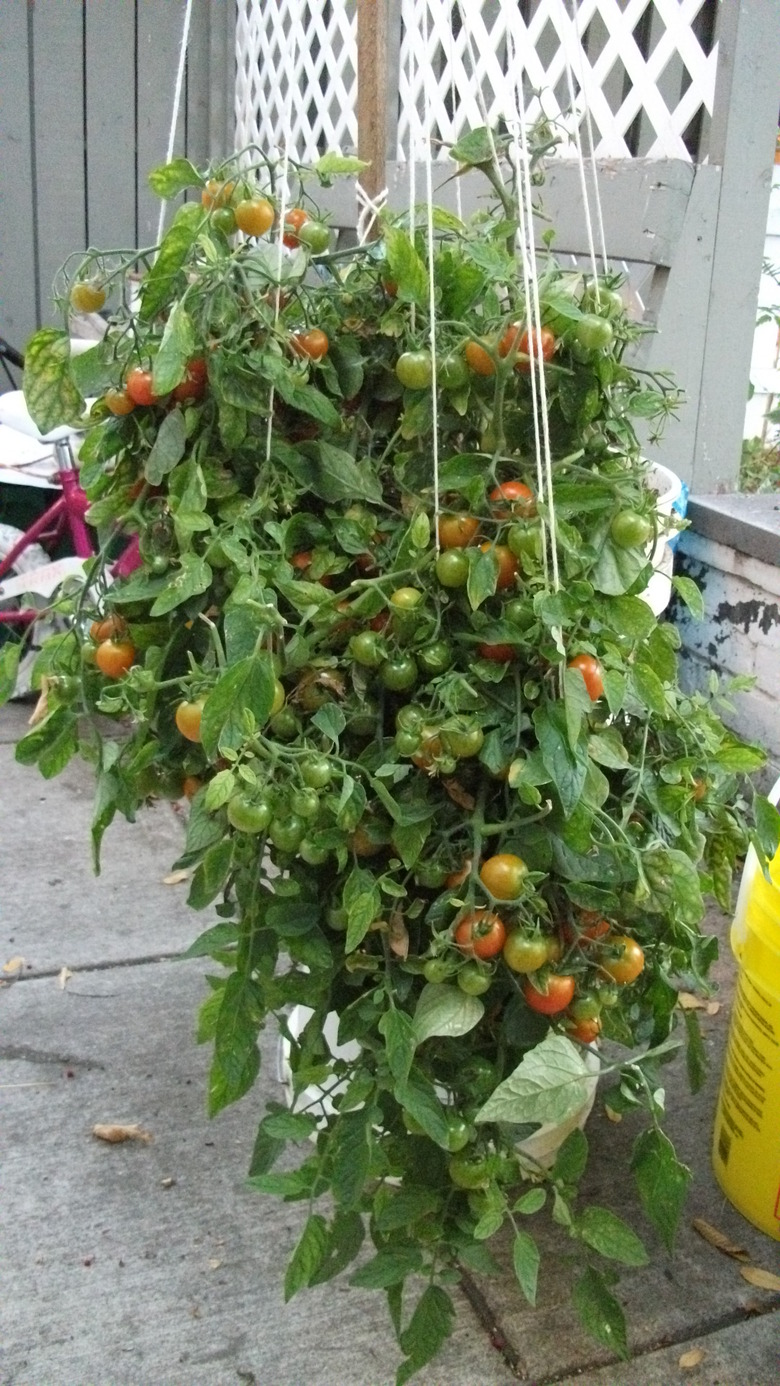How To Care For Hanging Tomato Plants
Small-space gardening presents some fun challenges which, when solved, can be very satisfying. One challenge is how you plan to grow your veggies, whether in containers or in the garden. Since tomatoes are the queen of the summer garden, they deserve some special consideration.
Do hanging tomato plants really work?
Container gardening is the first line of defense, and growing tomatoes (Solanum lycopersicum) in hanging containers is pretty easy. Along these lines, you might be thinking of creating an upside-down tomato garden, in which tomatoes sprout from the bottom of specially designed hanging baskets. However, tomato plants know up from down, and they will fight this arrangement.
A better option is to create your "tomato garden" in a pot right-side up, where the plant's proclivity for growing upward will make it a happier camper. You can still hang it on your balcony and choose a cultivar that naturally trails if your vision demands hanging baskets.
Growing Hanging Tomato Plants
If you're picturing tomato stems spilling artistically over a basket or container, choose those tomato varieties with a trailing habit to provide that graceful look.
Tomato Varieties for Hanging Baskets
Tomatoes with a trailing habit develop smaller root systems, so they can be confined to a smaller space. But they also have a prolific growth habit that results in enough supple foliage to hang over the sides of a container in a fountain-like manner. For instance, small bush tomato plants are not conducive to growing in hanging baskets.
Some excellent trailing varieties include:
- **Baxter's Early Bush Cherry Tomato:** Heirloom, determinate; matures in 72 days; a prolific producer.
- **Early Cascade:** Hybrid, indeterminate; matures in 55 days; has large tomato fruit clusters.
- **Florida Basket:** Hybrid, determinate; matures in 70 days; developed specifically for hanging baskets at the University of Florida.
- **Tumbling Tom:** Hybrid, determinate; matures in 70 days; a cherry tomato that is either red or yellow.
How to Grow Tomatoes in Hanging Baskets
First, choose your container. Because a hanging planter inherently limits the room for plant roots and soil, choose as large a basket or container as you can to ensure healthy, happy plants that will have lots of room to grow. A larger container will also maintain moisture better than a smaller one. Here are the basics:
- **Potting soil:** Use a soil that can retain water well. For instance, you could add vermiculite, perlite or water-retaining gel to ensure your tomato plants don't dry out.
- **Drainage:** Your hanging pot needs good drainage holes to avoid sitting water that can create rot problems.
- **Sun:** Tomatoes require full sun, which equates to at least six hours a day. This can be tough on a balcony or a patio, but too little sun will result in more foliage and fewer fruits.
- **Fertilizer:** Tomatoes are heavy feeders, so incorporate fertilizer into the soil when planting, and side dress more during the growing season. Use a nitrogen-heavy mix to start with—for instance, 20-10-10—adding more three weeks and then again six weeks later. At that point, switch to a more balanced mixture like 10-10-10 to encourage both foliage growth and fruiting.
- **Irrigation:** Plants in containers always require more water than you think, likely daily. Never let the soil dry out, especially because the rootballs of tomatoes growing in containers can dry out fast.
And rejoice! You won't need to stake tomatoes or purchase expensive cages when your goal is foliage that drapes over the side.
Growing Tomatoes Upside Down
While upside-down tomato planters are readily available commercially, few experts recommend this method, because it actually has a lot of downsides.
Check out these reasons why upside-down tomato plants aren't very happy, provided by Colorado State University Extension:
**Stems grow up:** Tomato stems will naturally grow up toward the sun so that the new growth creates a U curve as it reaches upward. This new growth is susceptible to breakage from wind or just its own weight as it grows. When these stems break, you lose new growth that could potentially yield fruit.
**The planter can shade the plant:** When the stems are underneath the planter, the planter itself can block important sunlight to the tomato, stunting its growth. It's hard enough to ensure sufficient sun for tomatoes growing in a confined space like a patio, but these planters make it harder.
**The roots have less room:** Planters sold commercially as upside-down options rarely have enough room for a robust root system. And if they are large enough, they will be so heavy when filled with potting soil and plants that it may be hard to find a good location or support structure on which to hang them.

